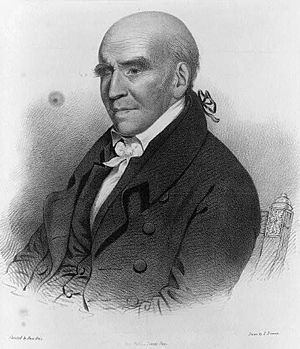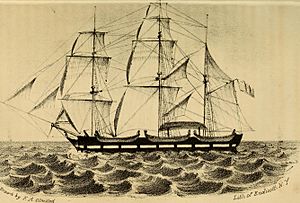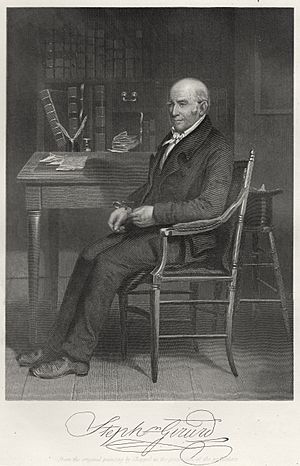Stephen Girard facts for kids
Quick facts for kids
Stephen Girard
|
|
|---|---|

Girard in 1831
|
|
| Born | May 20, 1750 Bordeaux, France
|
| Died | December 26, 1831 (aged 81) Philadelphia, Pennsylvania, US
|
| Signature | |
 |
|
Stephen Girard (born Étienne Girard on May 20, 1750 – died December 26, 1831) was a very important American businessman and helper of others. He was born in France but became a citizen of the United States.
Stephen Girard is famous for helping the U.S. government avoid a money crisis during the War of 1812. He used his own money to help pay for the war. He was also one of the first people in U.S. history to become a multi-millionaire. People think he was one of the richest Americans ever, based on how much money he had compared to the country's economy at the time.
He didn't have any children, so he used a lot of his wealth to help others. He especially focused on educating and caring for children who had lost their parents. His good deeds still impact his adopted home city of Philadelphia today. His money continues to support helpful projects even now.
Contents
Stephen Girard's Early Life
Stephen Girard was born in Bordeaux, France, on May 20, 1750. His father was a sailor. When he was eight years old, he lost sight in his right eye. He didn't get much formal schooling.
In 1760, he traveled to New York as a cabin boy on a ship. He stayed in America and worked on ships that traded goods along the East Coast and down to the Caribbean Sea. By 1773, he became a licensed ship captain. He started trading goods between New York, New Orleans, and Port au Prince. In May 1776, Girard sailed into Philadelphia to avoid some British warships and decided to live there. He opened a small grocery and liquor store.
By 1790, Stephen Girard had built up a fortune of $6,000 and owned a small group of trading ships. In 1791, his ships were involved in helping French landowners save their goods during the Haitian Revolution. He ended up with $10,000 worth of goods on his ships because the owners couldn't be found. Girard added these goods to his own wealth.
Girard also took part in the "Old China Trade," which meant he helped pay for voyages to Canton (now Guangzhou) in China. His business dealings in China stopped in 1824 after an issue involving one of his ships, the Terranova, and Chinese officials.
Helping During Yellow Fever
In 1793, a serious disease called yellow fever spread in Philadelphia. Many wealthy people left the city to avoid getting sick. However, Stephen Girard chose to stay and help those who were ill and dying.
He helped turn a large house outside the city into a hospital. He also found people to volunteer as nurses for the sick. Girard even personally cared for patients himself. Because of his brave efforts, he was celebrated as a hero after the disease outbreak ended. He continued to help the poor and sick during another yellow fever outbreak in 1797-1798.
Stephen Girard's Bank
In 1811, the charter (permission to operate) for the First Bank of the United States ended. Stephen Girard bought most of its shares and its building in Philadelphia. He then reopened it as his own bank, called Girard's Bank.
He hired the former cashier of the First Bank, George Simpson, and with seven other employees, the bank opened on May 18, 1812. Even though Pennsylvania law usually didn't allow groups of people to bank without a special charter, it didn't stop one person from doing it. Other banks in Philadelphia didn't like that Girard issued money based on his own credit. They tried to get the state to make him get a charter, but they didn't succeed.
Girard's Bank became the main source of money for the U.S. government during the War of 1812. He loaned the government a huge amount, about $1 million.
Near the end of the war, when the U.S. government was very low on money, Girard offered almost all of his wealth to help. He bought up to 95 percent of the war bonds, which allowed the United States to continue fighting the war. After the war, he became a major investor and a director in the Second Bank of the United States. Girard's Bank stopped operating after he passed away.
Later, businessmen in Philadelphia started a bank called the Girard Trust Company to use Girard's good name. This bank eventually became Girard Bank. It later merged with Mellon Bank in 1983. Its large main building is still a landmark in Philadelphia today.
Death and Lasting Legacy
On December 22, 1830, Stephen Girard was badly hurt while crossing a street in Philadelphia. A horse and wagon knocked him down, and a wheel ran over the left side of his face. This injured his cheek, ear, and his good eye. Even though he was 80 years old, he got up by himself and went home. A doctor treated his wound.
He went back to work at his bank, but he never fully recovered. Stephen Girard passed away on December 26, 1831. He was first buried in a Catholic cemetery. Twenty years later, his remains were moved to Girard College, a school he founded.
When he died, Stephen Girard was the wealthiest man in America. He was worth about $7.5 million at that time. This amount would be like hundreds of millions of dollars today. Some experts believe he was the fifth-wealthiest American of all time when adjusted for inflation.
Girard's family in France tried to challenge his will in court. However, the U.S. Supreme Court decided that his will was valid in a famous case in 1844.
He left almost all of his huge fortune to charities and city organizations in Philadelphia and New Orleans. A large part of his money, about $6 million (in 1831 value), was used to create a boarding school in Philadelphia. This school was for "poor, male, white orphans," especially those whose fathers were coal miners. This school opened in 1848 as Girard College.
Girard also gave $10,000 to the public schools of Philadelphia. The money from this gift was meant to buy books for school libraries and to create funds for awards for deserving students.
Interestingly, people used to say "Stephen Girard work" or "Stephen Girard job" to describe useless tasks. Girard didn't like people being idle. He would sometimes pay workers for tasks that seemed pointless, like moving bricks from one side of a yard to another and then back again. He did this to give people work rather than just handouts.
Places Named After Stephen Girard
Many places are named in honor of Stephen Girard:
- Girard Avenue is a main road in North Philadelphia and West Philadelphia. Girard College is located on this avenue.
- The neighborhood known as Girard Estate was once a successful farm owned by Girard. It includes Stephen Girard Park, where his old "country mansion" still stands.
- Girard Fountain Park is in the Old City area of Philadelphia. It has a sculpture of Benjamin Franklin.
- The town of Girardville in Schuylkill County, Pennsylvania, is about 110 miles northwest of Philadelphia. It is near many acres of land still connected to the Girard Estate.
- Stephen Girard Avenue is in the Gentilly area of New Orleans.
- Girard, Pennsylvania in Erie County, Pennsylvania, was named after him in 1832.
- The community of Girard, Louisiana, is in Richland Parish, Louisiana. Girard helped start a plantation there in 1821.
- A Liberty ship (a type of cargo ship) built in 1942 was named USS Stephen Girard.
See also
- Stephen Simpson (writer)
- List of richest Americans in history
- List of wealthiest historical figures
- War of 1812





